15 A Film Scholar Teaches Evaluative Writing
Graig Uhlin
Push play on the sound bar above to listen to the chapter.
17 min read
AFilmScholarTeachesEvaluativeWriting._print
What You Will Learn in this Chapter
Evaluation is a common practice in media consumption. We routinely judge, rank, and rate films, television shows, and other media as good or bad, as worth watching or not. In this chapter, we will consider strategies for evaluating film that go beyond the subjective opinions of the viewer. This involves an approach to media that is object-oriented (emphasizing textual meaning) rather than viewer-oriented (emphasizing personal reactions). The chapter introduces the critical practice of identifying textual functions as a means of understanding the expressive aims of a film. It then stresses the importance of considering form when evaluating media and offers a comparative example of one particular formal element of film, known as mise en scène. On reading this chapter, students are invited to consider standards of evaluation that extend beyond like and dislike.
Key Terms
- Function
- Convention
- Mise en scène
Did you like the movie? We’ve all heard this question, uttered as people leave a theater or close Netflix. Much of our interaction with media is structured around liking things. Are the thumbs up or down? Is the tomato fresh or rotten? Like, comment, subscribe! Netflix, YouTube, and other streaming services are continually modifying their recommendation algorithms so that they better deliver content they think you will like. In fact, the entire media industry is devoted to being able to predict whether audiences will like something or not.
The likability standard is a common one, then, when evaluating film – or other types of moving-image media such as television, video games, and social media – but is it a useful one? It has its limitations. First, one’s personal taste is, by definition, subjective. Just because you liked something does not mean that I will. You might want a film to tell a compelling story; I might be more interested in its visuals. You might need the film to be realistic; I might prefer more fantastical material. Our definitions of what constitutes a “good” movie, therefore, might be quite far apart, with no way to arbitrate this difference. No wonder Netflix allows for multiple profiles on the same account!
The problem with using enjoyment as our metric is that saying you liked something ultimately tells us more about you than it does about the media object itself. It tells us what you find interesting, suspenseful, scary, or boring, but those are labels that you attach to a film, not some intrinsic property of it. Nothing is inherently boring; it is always boring to someone.
A second limitation of the likability standard is that it privileges the familiar. What we have liked in the past we will continue to like, and these repeated consumption habits can overlook content that is different or challenging. Like or dislike are poor metrics for the variety of media texts, which may be intentionally uncomfortable, informative, intriguing, ambiguous, complex, objectionable, or obscure. A critic must be attuned and open to what responses the text wants to provoke or experiences it wants to express.
How do we evaluate film, if we want to move past liking and enjoyment as our criteria? Valuable criticism means engaging with a film on its own terms. It is generally not viewer-oriented (emphasizing personal reactions) but object-oriented (emphasizing textual meaning). The goal is to make sense of the media text you’ve just watched, even if you find it unpleasurable or confusing.
Film studies has developed useful concepts for evaluating moving-image texts, two of which I will discuss in this chapter. The first is textual function, which Russian formalist critics introduced in the early 20th century for the study of literature. An emphasis on function, which describes the intended effect of a textual device, keeps our focus on the text rather than on the responses of viewers. The second is the formal element of mise en scène, which refers to the non-cinematographic aspects of staging a scene. We will consider mise en scène as part of a broader demonstration of how to critically evaluate a film.
FUNCTION: What a Film Does
To understand the concept of textual function, let’s consider a specific example. In the opening scene of Jean-Luc Godard’s Vivre sa Vie/My Life to Live (1962), the protagonist, Nana, sits with her husband at the counter of a Paris café as she tells him that she is leaving him to become an actress. In filming this scene, Godard places the camera behind his actors, so we only see the backs of their heads. This should strike us as unusual. The beginning of a film typically introduces its main character, but here we are prevented from seeing her face throughout the scene. What is the purpose of this atypical choice of framing? In other words, what is its function? Function names what a textual element, such as this specific camera placement, does rather than necessarily what it means. It is what justifies the presence of a textual device. Does it provide us with story information or reveal something about a character? Does it develop a theme or convey a mood? In our example from Godard’s film, the function of his camera placement is to forestall the viewer’s identification with the character. Rather than losing ourselves in the fiction, we are reminded of the artifice of filmmaking, since the unexpected position of the camera reminds us of its presence. Godard instructs the viewer not to approach Nana as a “realistic” character, but one who will be inscrutable; it will be difficult to figure out what motivates her or what she is thinking.
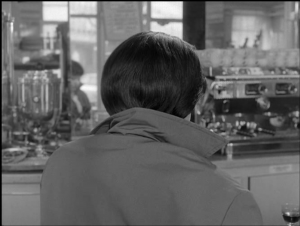
We can imagine some viewer dismissing this formal choice as “bad” filmmaking. You can’t see the actress’s face! Viewers have come to expect that a film will foster identification with the main character. We want characters to be “relatable.” However, if the intention is to prevent this identification with the character, then it hardly makes sense to find a film like Vivre sa Vie lacking on this account. Evaluative criticism, in other words, needs to meet a film on its own terms. Rather than imposing our own expectations about what a film should do, we must be receptive to its intentions and consider how well it achieves those aims.
Learning to recognize functions reorients your attention to commonly used formal techniques. When a textual device is consistently associated with a specific function, this is what we call a convention, or, when it becomes overused, a cliché. Some conventions are so widely used that they are simply accepted as part of the vocabulary of filmmaking; for example, a dissolve between two shots indicates a lapse of time. That an actor should face the camera is such a fundamental convention that perhaps we did not even perceive it as one until Godard violated it.
Conventions develop as creative practitioners – directors, screenwriters, cinematographers, actors, etc. – not only borrow from previous films but also innovate new forms. Consider, for example, the convention of parallel editing, where the film alternates between two spatially separate events that the viewer understands as happening at the same time. Before this convention trained audiences to see successive actions as temporally simultaneous, films used other formal strategies that look strange to contemporary viewers. The early silent film Life of an American Fireman (Edwin Porter, 1903) repeated the same story event twice from different perspectives. In one shot, filmed from the smoke-filled interior of a burning building, we see a rescue ladder appear in the window and a fireman enter to carry a mother and child to safety. In the next shot, we see the same action again, but this time from a point of view outside of the building. The filmmaker repeated the event because it was assumed that audiences would be confused by alternating between both perspectives.
Parallel editing addresses simultaneous actions in a different way, by cutting between them. This technique has become a standard feature of film narration, which means filmmakers can rely on viewers’ knowledge of the conventional meaning and innovate different uses of it. In The Silence of the Lambs (Jonathan Demme, 1991), the director utilizes parallel editing for a scene that depicts an FBI raid on the presumed location of the serial killer Buffalo Bill. Demme alternates between shots inside the house where Bill silences his female captive and outside the house as the agents surround the location. When Bill opens the front door, however, he finds only FBI agent Clarice Starling (Jodie Foster). The other agents were raiding the wrong house. Demme has played with our assumptions, using a familiar convention to lead us astray and then surprise us with an unexpected conclusion. Therefore, beyond simply enjoying the trick, a knowledgeable viewer will recognize how Demme utilizes a familiar convention in a new way.
The evaluation of film often requires us to consider how conventions change over time. When we judge a film as artistically praiseworthy or formally innovative, we do so with an awareness of how it modifies established conventions. Professional critics, for instance, see a lot of movies, and this makes them better equipped to contextualize a film’s formal choices within a director’s other work or other films in the same genre, or within the broader narrational modes and formal strategies that appear across the history of the medium.
To summarize, evaluative criticism is a critical engagement with media that is not limited to determinations of good or bad, like or dislike. An object-oriented criticism takes its cues from the film itself as to its intended functions, and it seeks criteria for evaluation that are not based in the personal reactions of viewers. What criteria might this include?
- Effectivity: What are the intended effects of a scene or of a film generally? How efficiently and effectively does it achieve those aims? We might find good reason to criticize an action film with unimaginative action set pieces or a musical with substandard musical numbers. Although viewers may disagree about what is frightening and what is not, we can still evaluate how competently a horror film achieves its scares.
- Originality: Does a film carry out its textual functions in a unique or unexpected way? Does the film utilize unconventional expressive means for its intended effects? We can evaluate a film in part based on the degree to which it breaks existing conventions or creates new ones.
- Complexity: Does the film produce textual devices that carry out multiple functions? Does the film create ambiguity, allowing for differing interpretations of the story? Does the film layer meaning, as for example, when an actor’s line delivery or subtle gestures suggest something other than the explicit meaning of their dialogue? A complex film will create a density of meaning that often rewards multiple viewings.
Let’s note that, while these criteria help us to move past a viewer-oriented criticism, they are not universally applicable. Take for example a film like Gus Van Sant’s Psycho (1998). This film is a shot-for-shot remake of Alfred Hitchcock’s famous thriller Psycho (1960). Van Sant cast new actors and shot in color, but except for these and a few other changes, his film is a nearly identical recreation of the earlier version. Is this film original? Nope! Originality as a standard for evaluation doesn’t work for this creative act of imitation. The film divided critics, many of whom could not see the point of Van Sant’s copying, but by confronting that question of why, object-oriented criticism can meet a film on its own terms and potentially expand our understanding of the artistic medium.
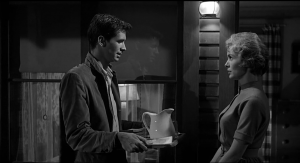
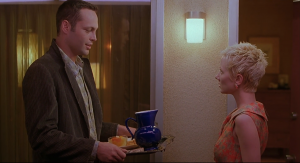
To cite another example, consider Andy Warhol’s Empire (1964). The film is an 8-hour shot of the Empire State Building from dusk to the early hours of the night. Apart from the lights of the building switching on, nothing happens. There are no characters or story, the camera never moves, and the shot never changes. Is this film complex? Definitely not! But complexity is not relevant to Warhol’s provocative gesture of confronting his viewer with an unchanging image for hours. Why would he create such a purposefully boring movie? This is what criticism can tell us if it is open to the idea that the art of film is dedicated to more than just enjoyment. Evaluative criticism needs to apply standards of evaluation that fit the object under scrutiny.
MISE EN SCÈNE: Considering Form
If tasked with evaluating a film, then, where does one begin? Casual viewers, including undergraduates in a composition class, tend to focus on narrative. Was the story engaging? Were the characters interesting? This attention to story, however, often causes us to overlook form. If narrative refers to the what of the story, then form refers to the how.
To achieve any textual function, a filmmaker must determine the means of expression. Should the conversation between two characters be presented in a single take or through an edited sequence of separate shots? Should the camera move in this scene, and if so, in what way? A film is nothing more than the end-result of thousands of decisions about what form it should take depending on what meanings it intends to express. Different choices lead to different effects. Moreover, film has properties that are unique to it as an artistic medium which distinguish it from literature, theater, or any other artform. When evaluating film form, we should ask to what extent and in what manner a film is making use of these formal elements, including editing, cinematography, and sound-image relations.
Let’s focus on one specific formal element: mise en scène. Mise en scène is a term that French film critics borrowed from theater, and it is now widely used in film studies. Literally meaning “to place onto the stage,” it is used to refer to all those components of a film image (called a “shot”) that are physically present when staging a scene. This would include the sets, costumes and makeup, props, lighting, staging (the arrangement of actors within the frame), and performance (the vocal and gestural aspects of acting). It does not include cinematographic elements such as framing, camera movement, or editing. If you were standing next to the camera during filming, all components of the mise en scène would be visible to you, but optical effects like a dissolve would not be. Mise en scène is one of the tools for conveying meaning available to filmmakers, and we can evaluate films based on the effectivity, originality, and complexity (or other standards!) of their use of this formal element.
A film’s mise en scène is unique to it, so direct comparisons can be tricky, but as an illustrative example, let’s examine how two directors stage the same scene between an original film and its remake. The scene in question comes from the film Imitation of Life, which was first adapted from Fannie Hurst’s novel by director John Stahl in 1934 and then again by director Douglas Sirk in 1959. The story features a young Black woman (named Peola in the 1934 film and Sarah Jane in the 1959 version) whose light skin tone allows her to pass as white. By passing, she can pursue professional opportunities and personal relationships that would otherwise be prohibited to her because of her race. However, doing so also requires that she renounce her mother (Delilah, then Annie) whose presence “outs” her as Black. This is what happens in our chosen scene: Peola/Sarah Jane has secured a job but has not told her mother. Looking for her, her mother shows up at her place of employment, causing her to lose her job once her racial identity is revealed. By examining how each director stages the same story event, we can evaluate their use of mise en scène to express meaning.
A full analysis is not possible in this short chapter, so let’s focus on a few revealing differences. In the 1934 version, Peola works as a hostess at a restaurant. Positioned behind a sale counter, she is conservatively dressed. Her facial expressions and body language indicate a friendly demeanor until Delilah enters the establishment. In the 1959 film, Sarah Jane has a different occupation. Though she told her mother that she had a “respectable job” at the library, she actually works as a lounge singer in a seedy club. The scene presents her scantily clad on a small stage performing a song for male customers shown staring at her lasciviously. Whereas the lighting in the restaurant was even, brightly lighting the interior, the lighting in the club has deep shadows. In both versions, the young woman denies knowing her mother and pretends that the woman must be “crazy.”
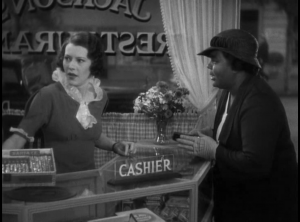
What conclusions can we draw from these changes in the setting, costuming, and lighting? Sirk’s staging, we might argue, better develops the film’s theme of racial passing, since the visual presentation of Sarah Jane’s job as a showgirl (as opposed to Peola’s) depends on soliciting male attention through the visual display of her (seemingly white) body. In the Stahl film, it is only the fact of Peola having a job at issue, so the staging plays a minimal role thematically, but in the Sirk version, it is more clearly established how Sarah Jane’s desire for social advancement depends on her ability to appear as a white woman. There are moral implications to this staging as well. Sirk’s version raises the stakes of Sarah Jane’s renunciation of her mother by suggesting the moral depravity of the world into which she has escaped.
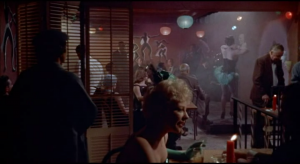
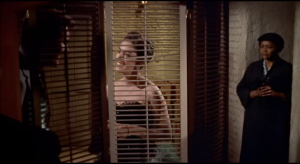
Another significant contrast concerns each scene’s depiction of Delilah/Annie. In both versions, this maternal figure is caring and virtuous, but in Stahl’s version Delilah lacks agency. When Peola denies knowing her, Delilah says nothing and lowers her head in painful suffering from the insult. She is accompanied to the restaurant by her employer Beatrice Pullman, and it is this woman who reproaches Peola for her denial of her mother. In the Sirk film, Annie confronts Sarah Jane herself, and rather than being silent, proudly and assertively claims her daughter as her own. Moreover, Sirk utilizes aspects of the setting to visually express the shifting dramatic conflict of the scene. Slated screens separate characters in the frame. Annie is first shown watching Sarah Jane’s performance through one, and when she announces herself as her mother, a screen is used to divide Sarah Jane from her male companion. This visible dividing line reinforces the viewer’s perception that this interracial romance is now over.
The important point to emphasize is that Sirk’s subtle and thoughtful use of mise en scène amplifies the underlying meaning of the scene. By means of the choices he makes, Sirk revises the racial politics of the earlier film. Peola’s racial passing is a narrative of tragic suffering, but the 1959 film’s depiction of Sarah Jane assists in its criticism of a racially segregated society. The same story expressed in a different form can result in radically different meanings. Evaluative criticism, therefore, benefits from a close attention to film’s formal elements.
As this chapter has emphasized, evaluation is closely related to the analysis or interpretation of texts. Evaluation involves the identification of standards or criteria for determining the relative quality of a film or other media text, but it derives those standards not from the personal taste of the viewer. Instead, evaluation considers the intended aims of the film (its textual functions) and judges how it utilizes the formal properties of the medium to achieve those aims. It seeks to understand how a film’s use of form fits within established conventions to assess its originality and inventiveness.
Discussion Questions
- What are possible criteria, apart from like or dislike, by which viewers can assess the quality of a film?
- What are some basic formal conventions in film that you are familiar with from your own viewing? What is an example of a film that modifies, breaks, or uses a convention in a unique way?
- What is an example of a significant or noteworthy use of mise en scène from a film?


